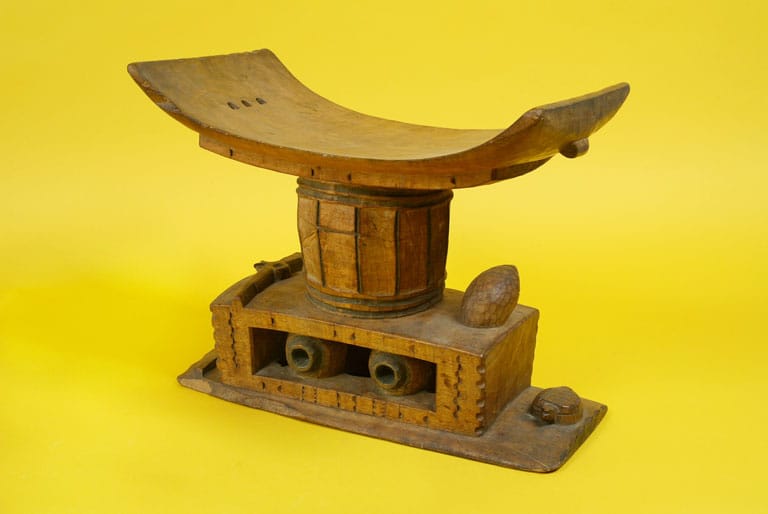Summary
- The Denkyira Empire emerged in the early 16th century, rising to power through control of gold-rich regions and dominance in trade with Europeans, especially along the southwestern coast of present-day Ghana.
- As Denkyira expanded by conquering rival Akan states like Asen and Twifo, its quest for regional dominance and control over the gold trade brought it into conflict with the rising Asante Kingdom.
- The Denkyira Empire fell in 1701 when Osei Tutu I, after uniting various Akan states, led a well-planned ambush at the Battle of Feyiase, marking the end of Denkyira’s reign and the rise of the powerful Asante Empire.
Before the powerful Asante Empire emerged, there was the Denkyira Empire, another nation of Twi-speaking Akan people in present-day Ghana. The Denkyira Empire originated at the start of the 16th century as a small kingdom called Agona. By 1620, it was renamed Denkyira, ushering in the birth of a powerful empire in modern Ghana’s southwestern coast.
In the 1690s, Denkyira fought with Asen and Twifo, two Akan kingdoms situated in coastal areas. Twifo, which has its ancient capital at Hemang, was especially popular with the Europeans for trading very high-quality gold. Denkyira wanted better access to the coastal trade with Europeans and the great Fante Confederacy, but Asen and Twifo stood in the way. After Denkyira had absorbed these territories, Denkyirans were able to control many of the major extractive areas of the gold-mining industry.
Thus, the Denkyira Empire rose to prominence through gold production and trade with Europeans, especially the Dutch. The Denkyira Empire and the Fante State dominated trade with Europeans in present-day western Ghana, while the Akwamu (another Akan state) dominated trade with Europeans in eastern Ghana.
However, the quest for gold dominance and hegemony in the Akan region also landed Denkyira in conflict with the Asante Empire. This ultimately led to Denkyira’s dissolution into Asante in 1701.
In this article, we will discuss the intriguing events that led to Asante’s conquest of Denkyira.
The Making of a Revolutionary
Before exploring how what came to be known as the Asante Empire conquered Denkyira in 1701, it is crucial to first look at the story of Osei Tutu I, the Asante ruler (Asantehene) who turned the tides for his people. Osei Tutu was the next in line to rule the kingdom of Kwaaman, one of Denkyira’s tributary kingdoms.
Denkyira had a custom of holding heirs to subordinate kings hostage so they could indoctrinate them to have a positive view of the imperial system. Accordingly, when Osei Tutu turned 16 years old in 1676, he was ordered to leave his people and follow a representative of the Denkyirahene to the Denkyira Royal Court. There, Osei Tutu got so immersed in the ways of the Denkyira court that he was eventually made a royal shield-bearer.
However, Osei Tutu had also gained a reputation as a philanderer who was popular with the ladies of the court. He was rumoured to have a relationship with Princess Akobena Abensua, a close relative of the Denkyirahene (ruler of the Denkyira). Princess Abensua was married to a high-ranking Denkyiran dignitary. Thus, when she fell pregnant and there was speculation over the paternity of the child, Osei Tutu fled to Akwamu, the Akan state that was farthest east from Denkyira.
Luckily for Osei Tutu, the Akwamu ruler, Sasraku took a liking to him. Moreso, the Akwamu were enemies of the Denkyirans at the time. While in Akwamu, Osei Tutu digested a lot about the military operations and socio-political structure of the Akwamu. He would later draw inspiration from his learnings for his future reforms as Asantehene.
Circa 1680, after spending a few years in Akwamu, Osei Tutu got word that his uncle (Obiri Yeboa) had been killed. Consequently, Osei Tutu would have to return to Kwaaman and assume the role of the Kwaamanhene. However, Osei Tutu feared that his return would be too dangerous since he was still a fugitive. Offering support to his now ally, Sasraku deployed 300 Akwamu warriors to accompany Osei Tutu to Kwaaman. The passage was successful and soon, Osei Tutu’s throne was established.
As Kwaamanhene, Osei Tutu desired for his people as well as other tributary Akan states to be free from Denkyira’s reign. Along with his close associate Priest Okomfo Anokye, he charged the chiefs of the Amantoo (the region of Akan-speaking peoples) to forge an alliance against their imperial state. The chiefs converged at Kwaaman for the installation of the paramount chief of the Amantoo. After consulting the divine for days, Priest Anokye appointed Osei Tutu as the Amantoohene. The Amantoo could then begin planning for war against Denkyira.
The Master Becomes the Subject
The war between Denkyira and the Amantoo had been a long time coming, as the Amantoo states had desired their freedom from Denkyira’s oppressive rule. However, many sources claim that the act that lit the match was Denkyirahene Ntim Gankyari’s decision to demand absurdly costly tributes from the Amantoo. The new tributes were to include each Amantoo chief’s finger and favourite wife, alongside the large amount of gold dust they typically sent. Additionally, Gankyari commanded that the Amantoo union be dissolved.
In response, the chiefs sent a brass basin filled with stones instead of gold, and fingers of the Denkyira messengers instead of their own fingers. They also killed the warrior amongst the messengers. Thus, war was declared and both sides had only to prepare.
On the Amantoo side, both tactical and spiritual preparations were made. Anokye called for three volunteers who would sacrifice themselves for the sake of the Amantoo’s victory. The first would be buried alive, the second would be butchered to death, and the third would lead marching soldiers to war but refuse to shoot.
As the war commenced in 1699, the Denkyirahene became even more tyrannical to his subjects. This led some of the tributaries to switch allegiance from Denkyira to the Amantoo. The first town that reportedly did so was the Abooso people, but the departure that impacted the Denkyira the most was that of the Nkawie people. Nkawie was the second most important town in the Denkyira Empire. Additionally, Nkawie’s leader, Asenso Kufuor had great sway over many of the Denkyira people, including noble folk.
Still, the Denkyirahene was assured of his inevitable victory. The Denkyira army was much more experienced in combat. They had sophisticated weaponry, including multiple Dutch cannons. Gankyari’s diviner Kenyeke pulled out all his tricks to counteract Anokye’s magic. And most of all, the loyalty of the Denkyirans to their Denkyirahene was much stronger than that of the newly formed Amantoo union to their Amantoohene.
The Denkyirans won the early battles of the war, driving out Amantoo forces from Abunku, Abountem and Aputuogya. However, the tides changed in 1701, when the Amantoo (who had now renamed themselves ‘The Asante Empire’) employed their wiles to come out on top. Unbeknownst to Gankyari, Osei Tutu had planned all along to ambush the Denkyira troops at Feyiase.
On the D-Day, the full force of the Ashanti fell upon the Denkyira army. The Ashanti forces completely surrounded the now destabilised Denkyiran army, leaving no room for escape. Gankyari was killed by the people of Adunku from Asante Feyiase and his body parts were shared between some of the Ashanti chiefs. The Denkyirans were killed or captured and sold into slavery—only a few were able to flee after capture. Their cannons were seized. And most importantly, the hegemony of the Denkyira Empire was brought to an end.
The Slave Empire
After the Denkyiran army was decimated, the Denkyiran territories were left unprotected and exposed. The Ashanti, Adanse and Twifo then seized the territories and shared them between themselves, with the former taking the largest share. Within Osei Tutu’s territory, the villages of Dominase and Agyemasu were founded.
Pockets of uprisings rose amongst the Denkyira for years, but by the war’s end in 1707, they were fully quelled. The Ashanti established undebatable dominance, giving them access to the coastal trade with the Europeans. Denkyira never again regained its powerful status, while the Ashanti built a formidable empire.
While it is unclear the extent to which the Denkyira Empire was involved in slave trade, Ashanti was well-known for building its economy on the back of slavery (as well as gold trade). It was said that the Ashanti exported thousands of slaves each year. Ashanti became one of the most important exporting areas in the trans-Atlantic slave trade, a legacy that remains a significant part of Ghana’s history.

Oyindamola Depo Oyedokun
Oyindamola Depo Oyedokun is an avid reader and lover of knowledge, of most kinds. When she's not reading random stuff on the internet, you'll find her putting pen to paper, or finger to keyboard.
follow me :
Leave a Comment
Sign in or become a Africa Rebirth. Unearthing Africa’s Past. Empowering Its Future member to join the conversation.
Just enter your email below to get a log in link.

